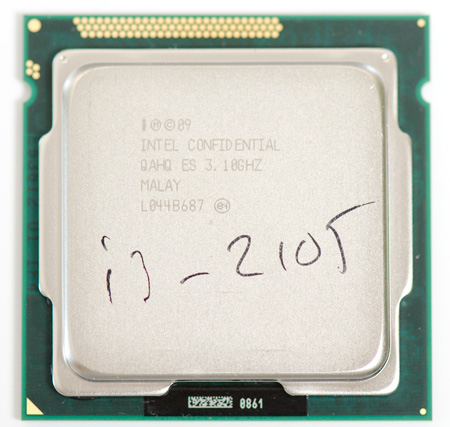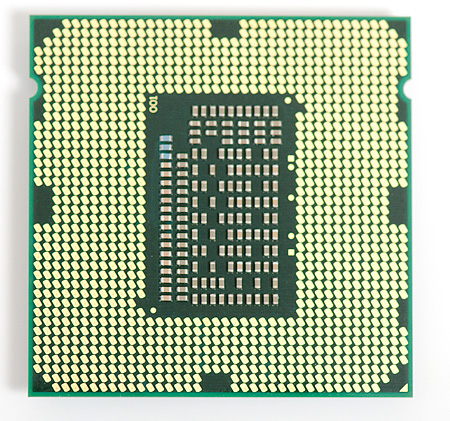The AMD A8-3850 Review: Llano on the Desktop
by Anand Lal Shimpi on June 30, 2011 3:11 AM ESTThe Direct Competitor: Intel's Core i3-2105
When Intel launched Sandy Bridge the only way you could get the faster integrated graphics option (Intel HD 3000) on the desktop was to buy one of the more expensive K-series chips. The logic didn't make a ton of sense given that lower priced systems are usually the ones that depend on integrated graphics. In the weeks before Llano's arrival however, we met a new member of the Sandy Bridge family - the Core i3-2105:

The 2105 is virtually identical to the 2100 it augments. It's still a dual-core processor (HT enabled) with a 3MB L3 cache . There's no turbo boost and you still get all of the same checkbox features (e.g. Quick Sync, VT-x, no VT-d, no AES-NI, etc...). There are only two differences between these two parts. The i3-2105 has an Intel HD Graphics 3000 core vs 2000 in the 2100, and the 2105 is priced at $134 (one dollar cheaper than the A8-3850).

It's clear that this HD 3000 equipped Core i3-2105 is intended to compete directly with the A8-3850.
The Test
The CPU tests in this review use an identical configuration to everything else in Bench (4GB memory, Intel X25-M SSD, discrete GPU etc...). The table below is for the processor graphics comparisons. All Intel HD 3000 numbers were generated using the Core i3-2105.
All discrete GPUs use our standard GPU testbed (3.33GHz Nehalem). This does prevent our usual efforts to keep our testbeds identical, however with low-end GPUs the contamination should be minimal as we’re GPU bound and then some, rather than being CPU bound.
| CPU: | AMD A8-3850 Intel Core i3-2105 |
| Motherboard: | ASUS P8Z68V-Pro (Intel Z68) ASRock A75 Extreme6 (AMD A75) |
| Chipset Drivers: | Intel 9.2.0.1025 AMD Catalyst 8.862 RC1 |
| Hard Disk: | Corsair P256 SSD (256GB) |
| Memory: | G.Skill DDR3-1866 2 x 4GB |
| Video Drivers: | AMD Catalyst 8.862 RC1 Intel 2372 |
| Desktop Resolution: | 1920 x 1200 |
| OS: | Windows 7 x64 |










99 Comments
View All Comments
mino - Sunday, July 3, 2011 - link
Tell ya what. The benefit is we get paid trolls like you over here.jaydee - Thursday, June 30, 2011 - link
How many monitors can you connect to this with a discrete gpu? Can you do 3 or more DVI/HDMI montors between the motherboard output and a discrete gpu?j_iggga - Thursday, June 30, 2011 - link
The other dude hit it on the mark. The target for this is OEM parts for budget desktops. So the point about the discrete GPU being more cost effective is mootSo given that...it's great that finally everyone can game adequately.
1920 x 1080 on integrated? unheard of in my time
HangFire - Thursday, June 30, 2011 - link
OK, so maybe it's better than i3 for laptops. But what I was looking for in Llano was a greatly improved per-clock efficiency in the CPU, something that will drag AMD back into true competitiveness with Intel.Instead we get slight tweaking.
If Bulldozer doesn't deliver a better CPU than oft-tweaked cores dating back to Hammer, AMD is dead on the desktop. Low-end laptops will be the only place they can compete, at least until Intel completes implementing DirectX 10 and 11.
L. - Thursday, June 30, 2011 - link
Bulldozer will deliver .. and it will kill Intel at it's price point, I bet your head on that ;)And Intel will be dead on the Server market, you can expect a 30+% perf/watt advantage for Interlagos on release day, only dampened when Intel will release their first 22nm Xeon ---
More blood in the water, better market for us.
BSMonitor - Thursday, June 30, 2011 - link
Bet taken. Bulldozer will be an underclocked, overheating monster. AMD is 2 years minimum behind with Bulldozer.Ivy Bridge will be out before Bulldozer... Bet on that.
L. - Thursday, June 30, 2011 - link
AMD is 2 years in advance with bulldozer, as it is not designed as a desktop processor, but a byproduct of Interlagos, which will very likely take a lot of server market share from Intel.I'd like to see how AMD could be two years behind, when Intel has been stretching a core design from core1 to sandy bridge ;)
Bet on the fact that AMD has always priced their stuff right, Bulldozer is in i7-2600k range, that means it will beat it hands down.
Ivy will be a win in desktop for Intel, but then again, this depends on how fast both Intel and GF can get to 3d-gate 22nm. (which if we look at current trends would mean Intel 6 months before GF more or less).
BSMonitor - Thursday, June 30, 2011 - link
You are completely wrong. Bulldozer was scheduled for release in 2009. It is 2011. Hence 2 years.Considering Conroe processors still dominate Phenom II x2, x4, and x6 processors from AMD. I would say AMD is behind. About 3 generations.
GF is just now shipping its first 32nm chips. Still not a single heavyweight chip at 32nm. Intel has 32nm 6-core processors for over a year. Ivy Bridge is out this fall at 22nm.
Are you just completely drinking the AMD Kool-Aide or what?
silverblue - Thursday, June 30, 2011 - link
If I remember correctly, Bulldozer's design was torn up and started again from scratch in 2008. This would undoubtedly increase development time, especially if they completely changed the design.And for the final time, stop spreading BS about Conroe dominating Phenom II. Even Penryn doesn't. There are plenty of instances where K10.5 beats the Core 2 family and in most cases where Core 2 wins, the difference is marginal at best, not to mention that a) there aren't any hexacore Core 2s out there nor any with any turbo technology, and b) any sufficiently high performing Core 2 parts are massively more expensive than anything AMD is shipping.
I dedicated a HUGE post on this topic to you on Toms using Anandtech Bench data and you've obviously decided to ignore it so... believe what you like. :)
BSMonitor - Thursday, June 30, 2011 - link
Yeah, I exaggerated. But the only way to deal with the diluted is to use such devices. Perhaps they will think and research.Phenom II vs Core 2 is not even close clock for clock.
Phenom II only wins in scenarios where it is grossly clocked higher than the similar Core 2. The 9650 is a 3GHz part, Ph II 980 a 3.7GHz part.
http://www.anandtech.com/bench/Product/49?vs=362
The recently released 980 barely outperforms the 3 y/o Penryn Core 2.